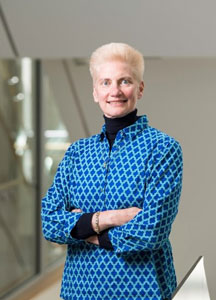
Diane Dalecki
Even before Biomedical Engineering became a department, Diane Dalecki wrote the curriculum for what was then a
fledgling interdepartmental program for undergraduates.
After the department was formed 15 years ago, she was among its first faculty members.
And on July 1, she became its second chairperson. She replaces Richard Waugh, who, she notes, “hired every one of us,
has done a fabulous job growing our department,” and to whom the department is “indebted for its existence.
“I have some very big shoes to fill.”
Waugh has no doubt she will do just that.
“Diane has been an exemplary contributor to the program from the very beginning,” he said. “She was our first
director of undergraduate studies. She ran our first accreditation visit. She started BME 101 and turned it into a
course that really had teeth and became a model for our EAS 10X courses (offered by departments school-wide). She
implemented hands-on labs as part of a freshman class that enrolls more than 100 students, which is no mean feat.”
“She’s always been there, extraordinarily dedicated and devoted to the department, and I think everybody senses
that.”
Waugh, 64, will continue to be a BME faculty member, run his research lab and serve as the University’s associate
vice president for research. However, he said the time seemed right to step down as department chair for a couple of
reasons. His wife, a schoolteacher, is retiring and he would like to have more time for travel.
Moreover, after 19 years as BME program director, then department chair, “I just felt like it was time to give
somebody else a turn,” Waugh said. “There are still opportunities for growth, so the new chair would still have a
chance to set some directions.”
The department, though relatively new, has had the largest undergraduate enrollment in the Hajim School for several
of the past few years. It has led the Hajim School in female enrollment and in numbers of female faculty. The
department’s programs for Senior Design and mentoring of junior faculty have served as a model for the rest of the
school.
Dalecki sees the department at a transition point. “For a long time we were a new department, then a growing
department, and now we are much more stable. That gives us opportunities now to tackle the things that will really
make us a robust, top-ranked BME program. That’s where we are headed next.”
The department, established in 2000, is a joint program shared by the Hajim School of Engineering & Applied Sciences
and the School of Medicine and Dentistry at the University of Rochester. It consists of 18 primary faculty members
with expertise spanning biomechanics, biomaterials, regenerative medicine, neuroengineering, nanotechnology,
imaging, and biomedical optics. The department enrolled 368 undergraduates and 70 graduate students during the
2015–16 academic year and led the Hajim School’s female undergraduate enrollment with 48 percent.
Dalecki is excited that the two new members joining the faculty this year – Edmund Lalor from Trinity College in
Dublin, Ireland, and Ross Maddox from the University of Washington -- both bring expertise in neuro-engineering,
which will strengthen not only the department but its ties with the Medical Center. Close association with a medical
center is “a cornerstone of any elite biomedical department,” she noted.
She’s also excited at the opportunity to work with the nearly 1,000 alumni of the department – nearly every one of
whom she has taught as freshmen.
“Our students when they are here, are so dedicated to our department,” Dalecki observed. “I want to maintain those
ties with them, and keep them interested in our department and engaged with the things we’re doing.”